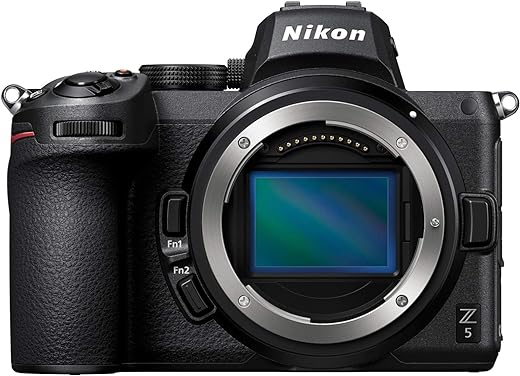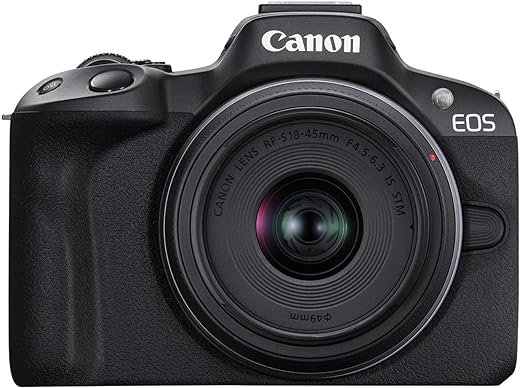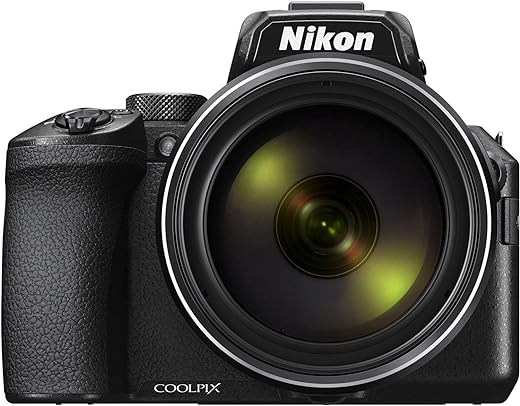Welcome! Today, we will delve into the world of Nikon mirrorless cameras as we compare the Nikon Z5 Compact Mirrorless and the Nikon Z50 Body Mirrorless Camera. These two models offer unique features and capabilities that cater to different preferences and needs. Let’s explore their differences and similarities to help you make an informed decision based on your photography requirements. Let’s get started!
Capturing moments
The Nikon Z5 is Nikon’s most compact full-frame mirrorless camera, offering outstanding image quality with sharp details and vibrant colors. It features 4K/30p video recording, eye-detection autofocus, 5-axis in-body image stabilization, and built-in WiFi and Bluetooth connectivity for easy sharing and control with a smartphone or tablet.
High Performance
The Nikon Z50 Mirrorless Camera offers high-quality images with its 20.9 MP DX CMOS sensor and EXPEED 6 engine, along with durable construction and weather sealing. It also includes convenient features such as built-in Wi-Fi and Bluetooth for easy sharing, a flip-down touchscreen LCD for self-portraits, and compatibility with a wide range of lenses.
Nikon Z5
Resolution
24.3MP Full-Frame
Video Recording
4K/30p and 1080/60p
Autofocus
Eye-Detection Autofocus
Image Stabilization
5-Axis In-Body
Connectivity
Built-in WiFi and Bluetooth
Nikon Z50
Resolution
20.9 MP DX CMOS
Video Recording
4K UHD Movies
Autofocus
209-point Hybrid AF
Image Stabilization
N/A
Connectivity
Built-in Wi-Fi and Bluetooth
Nikon Z5
Nikon Z50
Nikon Z5
Nikon Z50
Comparison Table


Nikon Z5:
- USPs:
- Full-frame mirrorless for compactness
- Dual SD card slots
- In-body image stabilization
- Pros:
- Superior sensor resolution
- Longer battery life
- Cons:
- Heavier body
- Use-Cases:
- Ideal for professionals needing high resolution and extended battery life
Nikon Z50:
- USPs:
- Lightweight body
- Fast and accurate autofocus
- High-speed image processing
- Pros:
- Lighter and more portable
- Good autofocus system
- Cons:
- Lower sensor resolution
- Use-Cases:
- Perfect for travel and vlogging due to its compact size and versatile features
Conclusive Assessment:
- If top-notch image quality and longer shooting sessions are crucial, the Nikon Z5 is the winner.
- For users prioritizing portability, speed, and versatility, the Nikon Z50 would be the recommended choice.
Final Summary:
In conclusion, the Nikon Z5 excels in resolution and battery life, catering well to professionals. On the other hand, the Nikon Z50 offers portability and speed, making it a great companion for travel and vlogging. Depending on your priorities, you can choose between superior image quality and endurance or lightweight versatility and high-speed performance.
Nikon Z5 vs Z50: Full Frame vs APS-C Mirrorless Cameras
Comparing Nikon Z5 Full Frame Mirrorless Camera and Nikon Z50 Mirrorless Camera
When comparing the Nikon Z5 Full Frame Mirrorless Camera with the Nikon Z50 Mirrorless Camera, there are several key factors to consider to make an informed decision. Here are some general guidelines and key factors to keep in mind:
Sensor Size:
- Nikon Z5 (Full Frame):
- Larger sensor sizes offer better low-light performance and dynamic range.
- Nikon Z50 (APS-C):
- Smaller sensor size potentially impacts image quality in challenging lighting conditions.
Resolution:
- Nikon Z5:
- Higher resolution for more detailed images.
- Nikon Z50:
- Slightly lower resolution but still capable of producing high-quality images.
Autofocus System:
- Nikon Z5:
- More advanced autofocus system with better subject tracking.
- Nikon Z50:
- Fast and accurate autofocus system suitable for general photography needs.
Body Design and Size:
- Nikon Z5:
- Larger and heavier due to the full-frame sensor.
- Nikon Z50:
- Compact and lightweight, making it more portable for travel and everyday use.
Lens Compatibility:
- Nikon Z5:
- Full compatibility with Nikon Z mount lenses.
- Nikon Z50:
- Same compatibility but with a crop factor due to the APS-C sensor.
Price:
- Nikon Z5:
- Generally higher priced due to the full-frame sensor.
- Nikon Z50:
- Usually more budget-friendly while still offering excellent performance.
Considering these factors, the choice between the Nikon Z5 Full Frame Mirrorless Camera and the Nikon Z50 Mirrorless Camera ultimately depends on your specific needs and preferences. Both cameras offer impressive features and image quality, so it’s essential to prioritize what matters most to you when making your decision.
Nikon Z5 vs Z50: Which Mirrorless Camera is Right for You?
Certainly! The key differences between the Nikon Z5 Full Frame and Nikon Z50 are primarily related to their sensor size and target audience.
The Nikon Z5 is a full-frame mirrorless camera, which means it has a larger sensor compared to the Z50, which features an APS-C sensor. The Z5 is designed for those looking for the benefits of a full-frame sensor, such as improved low-light performance and greater depth of field control.
On the other hand, the Z50 is more compact and geared towards enthusiasts and those looking for a lighter, more portable option without compromising on image quality. It still offers impressive features like a high-resolution LCD monitor and 4K UHD video recording.
Ultimately, the choice between the Nikon Z5 Full Frame and Z50 Body depends on your specific needs and preferences, whether you prioritize sensor size and image quality or portability and convenience.
Both cameras, the Nikon Z5 Full Frame Mirrorless Camera and the Nikon Z50 Body Mirrorless Camera, offer excellent image quality. However, the Nikon Z5, being a full-frame camera, generally produces higher-quality images due to its larger sensor size. Full-frame sensors have better low-light performance and typically produce sharper images with greater dynamic range compared to APS-C sensors like the one in the Nikon Z50. So, if image quality is your top priority, the Nikon Z5 would be the better choice between the two.
When comparing the autofocus capabilities between the Nikon Z5 and Z50, it’s important to note that the Z5 features a more advanced autofocus system than the Z50. The Z5 uses a 273-point hybrid autofocus system, offering improved speed and accuracy for capturing stills and videos. On the other hand, the Z50 comes with a 209-point hybrid autofocus system, which is also capable but not as advanced as the Z5’s autofocus capabilities. So, if autofocus performance is a critical factor for you, the Z5 may be the better choice due to its more sophisticated autofocus system.
When considering which camera is better suited for photography enthusiasts between the Nikon Z5 and the Nikon Z50, it’s essential to note that the Nikon Z5 is a full-frame mirrorless camera, while the Nikon Z50 is a crop-sensor mirrorless camera.
Photography enthusiasts often prefer full-frame cameras like the Nikon Z 5 due to their larger sensor size, which generally results in better image quality, especially in low-light conditions. Full-frame cameras also offer a shallower depth of field, allowing for more creative control over focus and background blur.
On the other hand, the Nikon Z50 is more compact and lightweight, making it a more portable option for photographers on the go. It also offers excellent image quality and performance, particularly for its price point.
Ultimately, if image quality and low-light performance are top priorities for photography enthusiasts, the Nikon Z 5’s full-frame sensor may be the better choice. However, if portability and affordability are key factors, the Nikon Z50 could be a suitable option.
Yes, there are significant differences in video recording features between the two cameras. The Nikon Z5 is a full-frame mirrorless camera that offers higher video quality with its larger sensor compared to the Nikon Z50, which has a smaller APS-C sensor. The Z 5 also provides more advanced video capabilities, such as better low-light performance and potentially superior dynamic range. Additionally, the Z 5 may offer more manual controls and settings for video recording, giving users greater flexibility and customization options.












7 thoughts on “Nikon Z5 vs Nikon Z50”
I wish the article had included information on the battery life of the Z5 vs Z50, as that is an important factor for me.
Overall, a well-written article that has helped me narrow down my choices between the Z5 and Z50. Thank you for the insights.
I would have liked to see a section discussing the video capabilities of both cameras in more detail. That would have been beneficial.
The ergonomic differences between the Z5 and Z50 are crucial for long shooting sessions. I would like to know more about this aspect.
I am considering upgrading my camera and this article has been very helpful in highlighting the key differences between the Z5 and Z50.
It would have been great to see more sample photos taken with both cameras to better understand the image quality differences.
Interesting comparison between the Z5 and Z50. I appreciate the detailed analysis provided in the article.
Comments are closed.